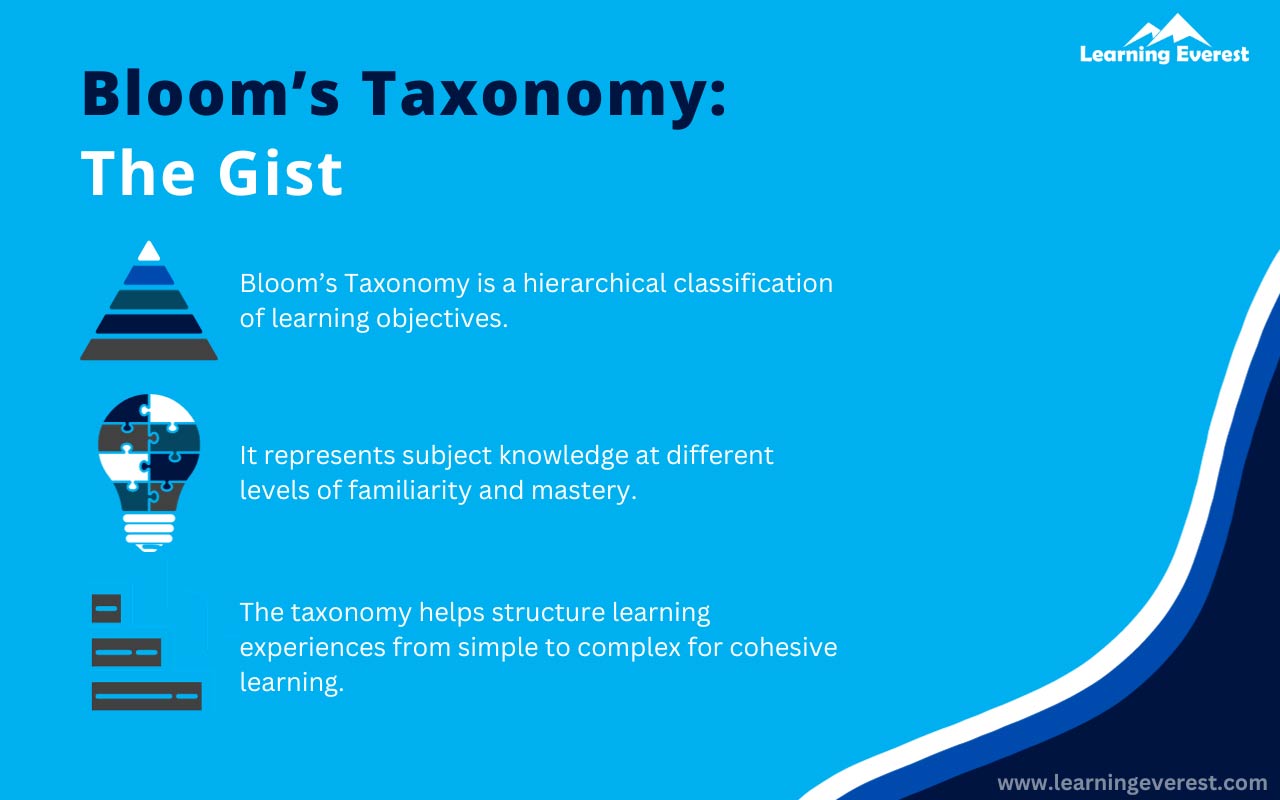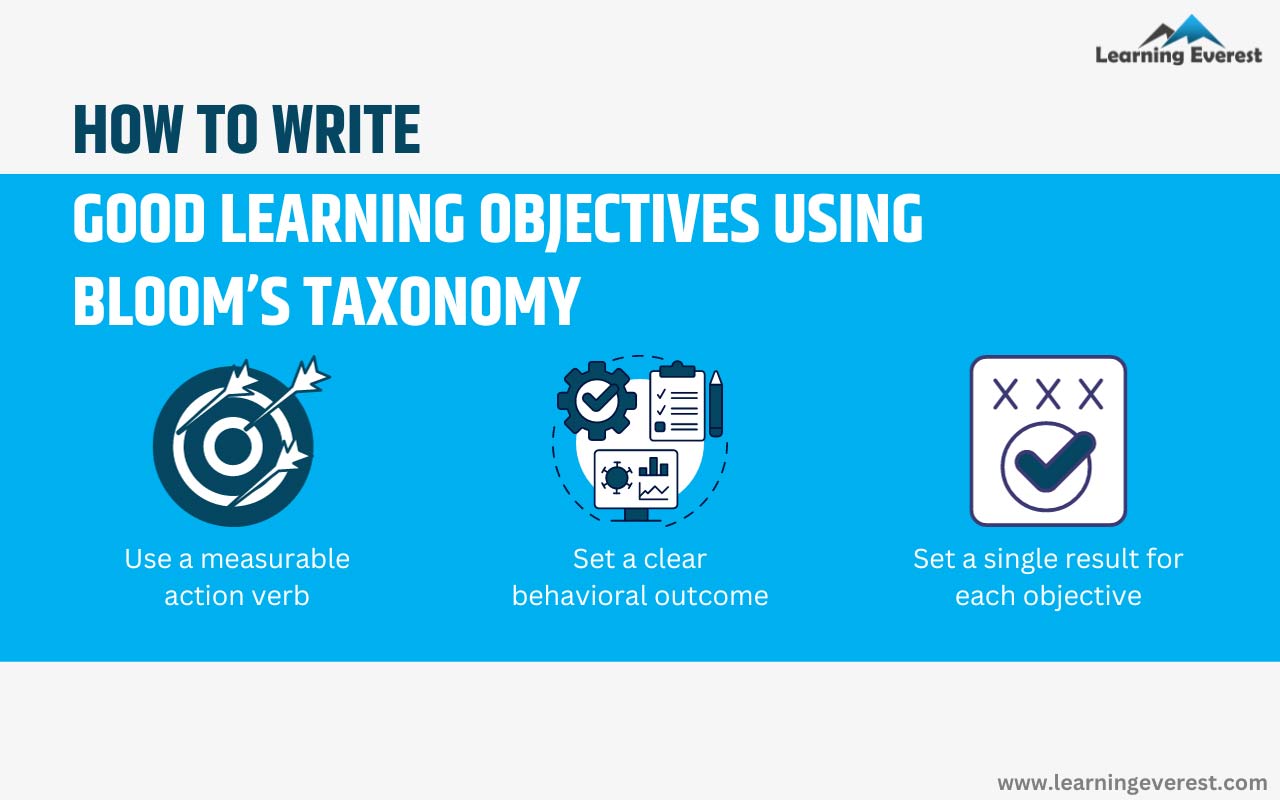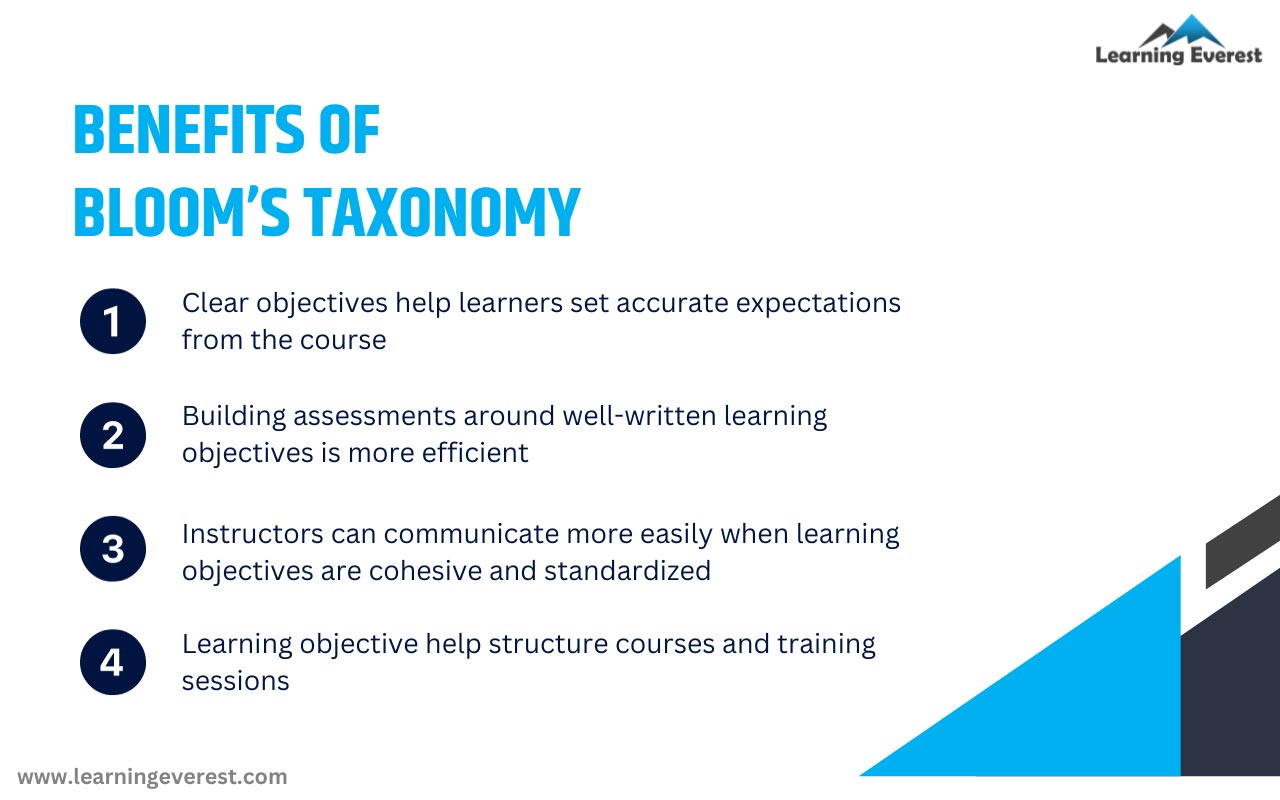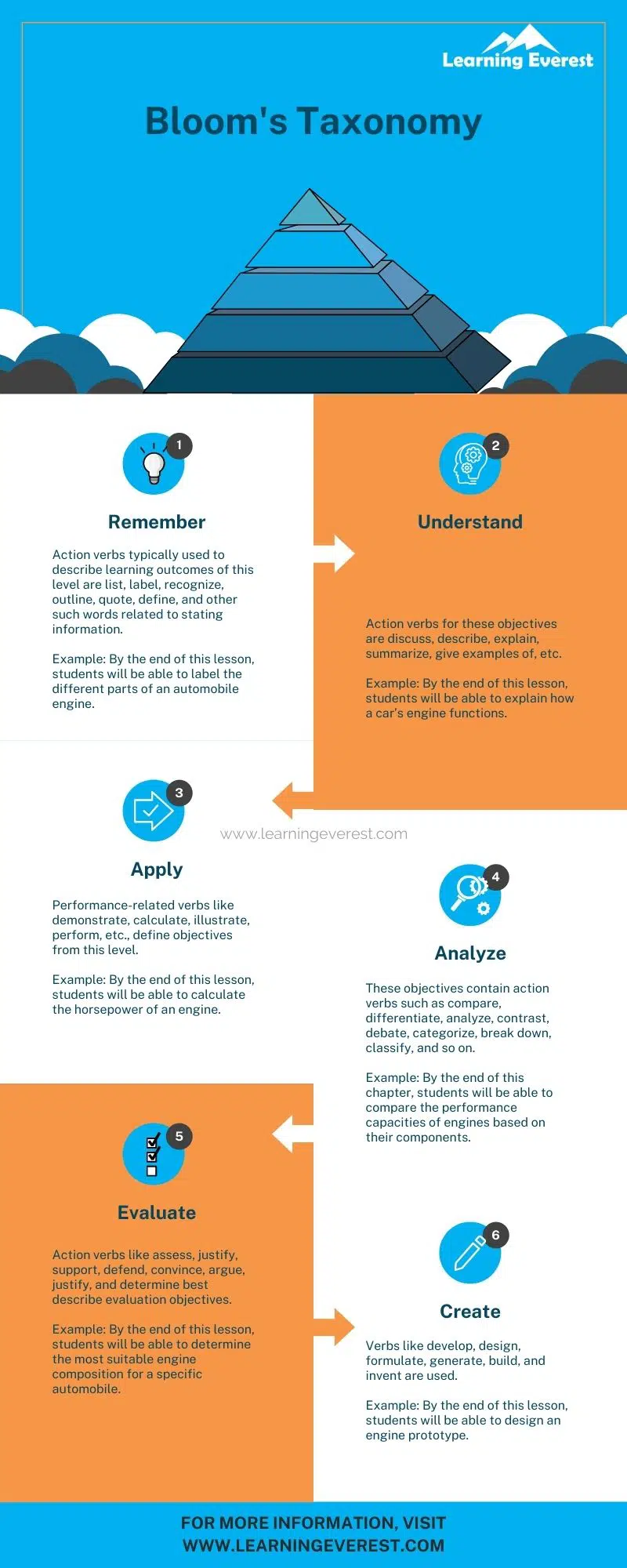Bloom’s Taxonomy is a popular framework used to formulate learning objectives in the learning and development and education sectors. First introduced in 1956 by Benjamin Bloom, with a revision in 2001, the model has been in use for almost 8 decades. The taxonomy comes from 16 years of extensive research by Bloom and his colleagues in the field of education and has stood the test of time. Let us look at how to put Bloom’s taxonomy into practice to write compelling and purposeful objectives for corporate learning.
Table of Contents
- Bloom’s Taxonomy: The Gist
- The 6 cognitive levels of the Bloom’s taxonomy
- Writing a Good Bloom’s Taxonomy Learning Objective
- The Importance of Well-Written Learning Objectives
- Conclusion
- Infographics
- Knowledge Check
- Frequently Asked Questions (FAQ’s)
- What are the 6 levels of Bloom’s Taxonomy?
- How is Bloom’s Taxonomy used in classrooms?
- What are some examples of Bloom’s Taxonomy?
- How does Bloom’s Taxonomy help us with planning lessons?
Bloom’s Taxonomy: The Gist
Bloom’s Taxonomy classifies learning objectives based on a hierarchy of 6 cognitive levels. These levels capture what constitutes subject matter knowledge at different stages of familiarity. To meet goals at a higher level, a learner must first exhibit mastery of the earlier levels. The different levels are depicted as a pyramid to highlight this hierarchical nature.
The original taxonomy had nouns for labels that were later revised as verbs in 2001 by Lorin Anderson, one of Bloom’s learners. Additionally, the higher ends of the hierarchy were also tweaked slightly. Overall, the 2001 revision adjusted the taxonomy to be more dynamic.
Changing labels from nouns to verbs helped emphasize the importance of observable and measurable behavioral outcomes in this framework. Under this method, outcomes must be described using clear and specific action verbs that can be measured to ensure the learning objective is met. The action verbs are indicators that the curriculum is producing the desired cognitive and behavioral changes in the learner.

Bloom’s Taxonomy – The Gist
The 6 cognitive levels of the Bloom’s taxonomy
The 6 levels of Bloom’s taxonomy are:
- Remember: This is the very first level of learning. It involves building familiarity and then attempting to recall, retrieve, and recognize the information. The learner mainly deals with factual knowledge about the subject matter at this level.
Action verbs typically used to describe learning outcomes of this level are list, label, recognize, outline, quote, define, and other such words related to stating information.
Example: By the end of this lesson, learners will be able to label the different parts of an automobile engine. - Understand: Understanding goes a level deeper. Learners get to know the course material in greater detail and find out the inner workings of concepts. Here, they build their own perception and interpretation of the information and its various components and are encouraged to then share or recite what they have come up with.
Action verbs for these objectives are discuss, describe, explain, summarize, give examples of, etc.
Example: By the end of this lesson, learners will be able to explain how a car’s engine functions. - Apply: At this level of Bloom’s Taxonomy, learners can put what they learn into practice and perform the practical skills that correspond with the information they acquire.
Thus, performance-related verbs like demonstrate, calculate, illustrate, perform, etc., define objectives from this level.
Example: By the end of this lesson, learners will be able to calculate the horsepower of an engine. - Analyze: Analysis objectives help learners take apart and dissect information to explore possible connections between concepts and compare and apply their learnings to novel situations and scenarios.
These objectives contain action verbs such as compare, differentiate, analyze, contrast, debate, categorize, break down, classify, and so on.
Example: By the end of this lesson, learners will be able to compare the performance capacities of engines based on their components. - Evaluate: At the evaluation level, learners start to use the information they have learned more independently. They make judgments, take calls, and make decisions based on well-defined criteria and standards. In other words, they analyze situations with a critical lens.
Action verbs like assess, justify, support, defend, convince, argue, justify, and determine best describe evaluation objectives.
Example: By the end of this lesson, learners will be able to determine the most suitable engine composition for a specific automobile. - Create: This is the highest level of learning one can achieve from a course. “Create” objectives require learners to apply the knowledge they’ve gained to construct something original. This could be a tangible product or policies and guidelines, and ideas. The goal is to get learners to develop their own solutions and contributions. Such objectives usually involve projects and assignments to facilitate practical application.
Verbs, like develop, design, formulate, generate, build, and invent, are used.
Example: By the end of this lesson, learners will be able to design an engine prototype.
Writing a Good Bloom’s Taxonomy Learning Objective
Bloom’s Taxonomy follows a particular structure for writing learning objectives. As previously mentioned, a learning objective needs to be measurable and specific and produce a behavioral outcome that accurately indicates the desired cognitive processes the course is attempting to build. Thus, the following key components should be included when writing learning objectives for a course:
- A measurable action verb (words and phrases like appreciate, recognize, understand, know, become aware of, comprehend, etc., should be avoided since they describe actions that aren’t very specific)
- A clear behavioral outcome of learning
- A singular result for each objective
Not every course will attempt to fulfill each level of Bloom’s Taxonomy. The learners and their previous experience with the subject matter will influence where in the hierarchy the behavioral outcomes lie. For instance, an introductory course might only focus on remembering, understanding, and applying knowledge. On the other hand, an advanced-level course might majorly concentrate on analysis, evaluation, and creation with a small module dedicated to revising the basics.

How To Write Good Learning Objectives Using Bloom’s Taxonomy
The Importance of Well-Written Learning Objectives
Well-written learning objectives provide direction to courses and help standardize delivery.
- They help learners anticipate what to expect from a course.
- Planning assessments becomes easier and more efficient with such specific objectives to meet.
- They simplify communication between different instructors.
- They provide structure to sessions.

Benefits of Bloom’s Taxonomy
Conclusion
Learning objectives are a key aspect of course design. Chalking down objectives is often one of the first steps L&D professionals partake in. Models like ADDIE, Kirkpatrick training model, and Merrill’s principles heavily rely on learning objectives when evaluating the overall success of a course and planning for future improvements and adjustments. Thus, Bloom’s Taxonomy continues to be a mainstay in education and learning and development.
Infographics

How to write learning objectives using Bloom’s taxonomy
Knowledge Check
Frequently Asked Questions (FAQ’s)
What are the 6 levels of Bloom’s Taxonomy?
The 6 levels of Bloom’s Taxonomy are remember, understand, apply, analyze, evaluate, and create.
How is Bloom’s Taxonomy used in classrooms?
Bloom’s Taxonomy classifies learning objectives based on a hierarchy of 6 cognitive levels. These levels capture what constitutes knowledge of subject matter at different stages of familiarity. To meet objectives at a higher level, a learner must first exhibit mastery of the earlier levels. The different levels are depicted as a pyramid to highlight this hierarchical nature. Under this method, outcomes must be described using clear and specific action verbs that can be measured to ensure the learning objective is met. The action verbs are seen as indicators that the curriculum is producing the desired cognitive and behavioral changes in the learner.
What are some examples of Bloom’s Taxonomy?
Example: By the end of this lesson, learners will be able to label the different parts of an automobile engine.
How does Bloom’s Taxonomy help us with planning lessons?
Well-written learning objectives provide direction to courses and help standardize delivery.
- They help learners anticipate what to expect from a course.
- Planning assessments becomes easier and more efficient with such specific objectives to meet.
- They simplify communication between different instructors.
- They provide structure to sessions.





